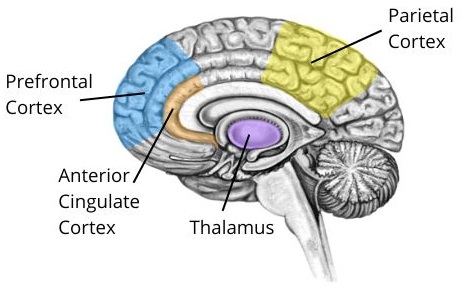How Attention Works: A Simple Look at the Neuroscience of Focus
Ever wonder why some days you can lock in and crush your to-do list – and other days your brain feels like a squirrel on espresso? The answer isn’t just about willpower. It’s about how your brain works.
In this article, we’re going to break down how attention works, what happens inside your head when you focus, and why it sometimes feels impossible. Plus, we’ll sprinkle in some cool neuroscience facts you can actually use to stay sharp.
What Is Attention, Really?
Attention is your brain’s way of choosing what to notice and what to ignore. It’s the mental spotlight that decides, “Hey, this is important right now” while dimming everything else in the background.
Without attention, life would feel like standing in the middle of Times Square, with every ad, honking car, and random thought fighting for your focus at once. Attention filters out the noise so you can zero in on what matters.
And here’s the thing: your brain is always paying attention to something – even when you think you’re zoning out. The question is, who’s in control? You… or your distractions.
The Two Types of Attention
Neuroscientists generally split attention into two categories:
- Intentional Attention
This is the attention you consciously control. It’s when you choose to read a book, focus on a work project, or follow a conversation. Think of it as manual mode for your brain. - Reactive Attention
This kicks in automatically when something grabs your focus – like a loud noise, a flashing light, or the smell of fresh pizza. It’s your brain’s way of quickly reacting to the environment for survival. Regardless of whether your attention is directed or automatic, specific brain regions work together to enable that focus.
The modern problem? Most of our attention these days gets hijacked by involuntary triggers – phone notifications, endless social media scrolls, breaking news alerts. This can also lead to “attention residue”, where lingering thoughts about previous distractions impair our ability to focus on the current task. And all of this leaves very little space for the deep, voluntary focus we need to actually get stuff done.
What Happens in the Brain When You Focus

When you focus on something, several key brain areas light up and work together like a team. Key neurotransmitters, like dopamine, also play a crucial role in maintaining this focus and motivation:
- Prefrontal Cortex
This is the command center, crucial for executive functions like planning, decision-making, and inhibiting distractions. - Parietal Cortex
It acts like your brain’s spotlight, playing a key role in the spatial aspects of attention, helping you direct your focus to specific locations or objects. - Anterior Cingulate Cortex (ACC)
The ACC monitors for conflicts – like when you’re tempted to check Instagram during work and helps redirect attention back to your task. It’s also involved in error monitoring and motivation. - Thalamus
This is your brain’s gatekeeper. It filters and prioritizes sensory input and decides what gets passed on for further processing.
When these areas sync up, you enter a state of deep concentration, also known as flow. This state can be characterized by increased alpha wave activity in the brain and a feeling of reduced activity in certain parts of the prefrontal cortex. Time flies, work feels easier, and distractions fade away.
Why Focus Is So Hard Nowadays
Here’s the uncomfortable truth: your brain wasn’t built for constant alerts and digital overload. It evolved to scan for danger and pay attention to sudden changes in the environment – a rustling bush could mean a predator.
The problem is, modern life triggers that same response with every buzz, ding, or pop-up notification. And because your attention is limited (like a battery that drains through the day), these constant interruptions leave you mentally exhausted.
Fun fact: research shows it takes about 23 minutes to fully refocus after a distraction. Imagine how much time we lose without realizing it.
The Neuroscience of Multitasking
You’ve probably heard this before, but let’s make it crystal clear: multitasking doesn’t work.
When you try to juggle multiple tasks, your brain isn’t doing them all at once. It’s rapidly switching between them – and every switch costs energy, time, and accuracy.
This “task-switching’ burns glucose (your brain’s fuel), increases stress, and leads to more mistakes. That’s why even answering a quick text while writing an email makes both take longer and feel harder.
Want to get more done? Focus on one thing at a time.
How Attention Works Over Time
Attention isn’t a constant – it rises and falls throughout the day based on your energy, mood, and environment.
- Morning:
Most people have their sharpest focus in the first few hours after waking up (especially after a good night’s sleep). This aligns with our natural circadian rhythm. - Midday Slump:
Around 1–3 PM, attention naturally dips. This is when distractions win and productivity drops. - Late Afternoon:
Energy and focus pick up again for a smaller “second wind”. - Evening:
Attention declines as your brain prepares for rest. This is when it’s harder to resist mindless scrolling or Netflix binges.
Knowing your focus rhythm helps you schedule important tasks during peak times and leave low-focus stuff (emails, admin work, errands) for slower periods.
Can You Train Your Brain to Focus Better?
Good news – yes, you can. Attention is like a muscle. The more you use it, the stronger it gets. Neuroscience calls this neuroplasticity – your brain’s ability to reshape and strengthen pathways with practice.
Here’s how to start:
- Practice Daily Focused Work Sessions
Use the 50/10 Rule or Pomodoro Technique to train sustained attention. These techniques are effective because they break down work into manageable chunks and provide regular breaks, helping to prevent mental fatigue. - Limit Multitasking
Close unnecessary tabs, mute notifications, and give each task your full attention. - Mindfulness & Meditation
Studies show even 10 minutes a day improves focus and reduces distraction by increasing gray matter density in the prefrontal cortex. This practice also enhances your awareness of your thoughts and improves your ability to control where you direct your attention. - Improve Sleep, Diet and Exercise
Your brain needs physical care to function at its best. Sleep deprivation alone can significantly reduce prefrontal cortex activity, impacting focus by up to 50%. A balanced diet provides the necessary fuel for brain function, and regular exercise improves blood flow to the brain. - Do Boring Things Without a Phone
Waiting in line? Sitting at the doctor’s office? Resist the urge to pull out your phone. Let your brain be bored. This helps rebuild your ability to tolerate boredom and reduces your reliance on constant external stimulation for engagement, ultimately strengthening your attention control.
Cool Focus Fact You Can Use
Scientists discovered a part of the brain called the Default Mode Network (DMN) – it’s active when your mind wanders or daydreams. This network involves areas like the prefrontal cortex. The more you practice focused work, the better you get at strengthening the neural pathways that allow you to switch this network off when it’s time to concentrate.
Training focus is literally like flipping a switch in your brain.
Final Thoughts
Focus isn’t about having superhero willpower. It’s about understanding how your brain works and working with it, not against it.
When you learn to control where your attention goes, you control what gets done, how well you perform, and how satisfied you feel at the end of the day.
So take back your mental spotlight. Know when your brain’s at its best, practice strengthening your attention muscle, and don’t let cheap distractions steal your time.
Because the truth is: whoever controls your attention controls your life.
